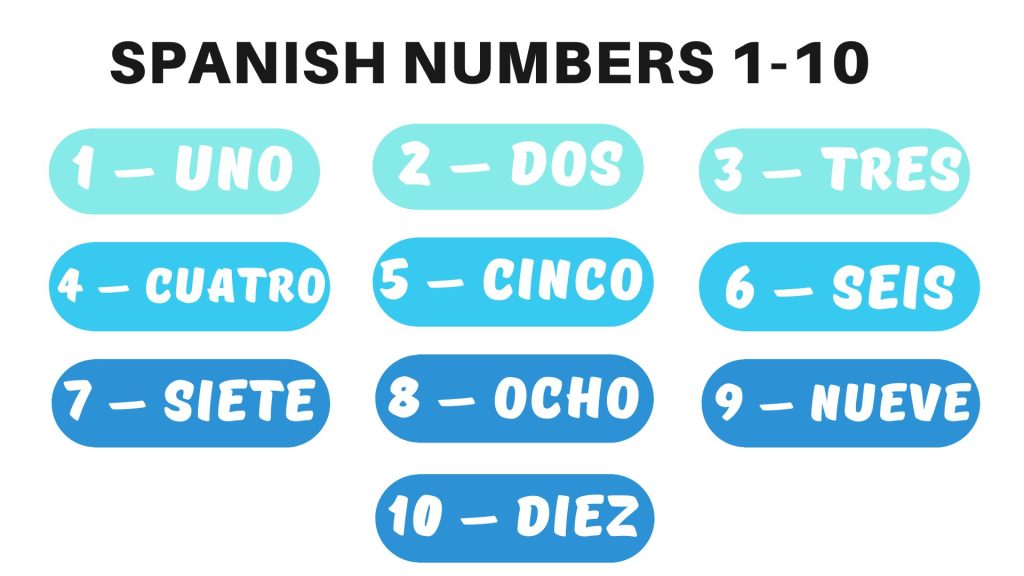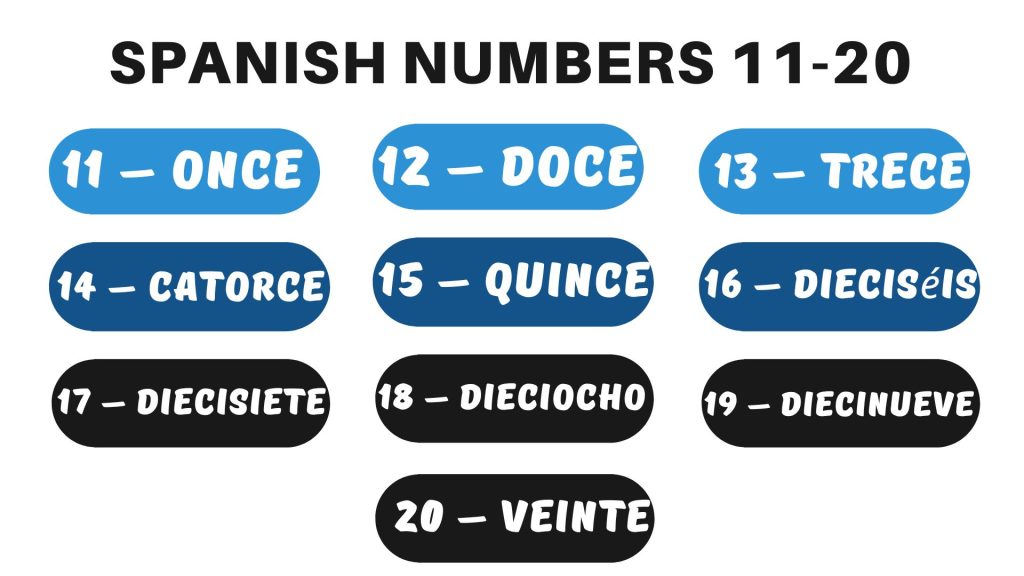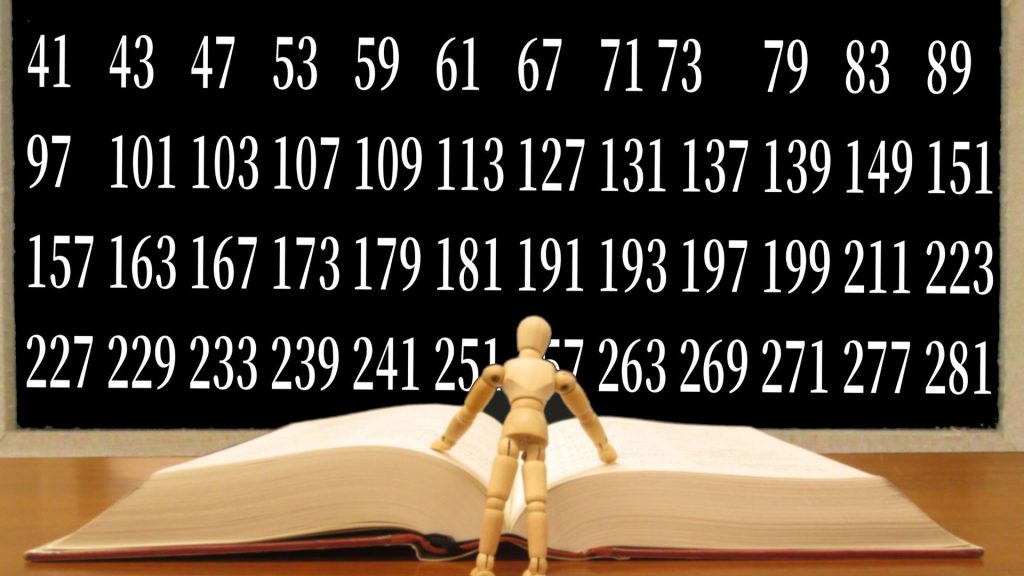Learning Spanish numbers from 1 to 100 is more than just counting. It’s about getting to grips with the basic patterns and structures needed to handle numbers in Spanish. The first few numbers might seem a bit odd, but as you learn more, things start to follow a more regular pattern. This helps not just in everyday talk but also sets you up for handling more complex stuff like dates, amounts, and money matters.
As we dive deeper into these numbers, you might start to see how these basics help in more advanced language tasks and in understanding cultural subtleties that show up in daily conversations and dealings in Spanish-speaking places.
Learn to count – Spanish numbers 1 to 100
Learning Spanish numbers from 1 to 100 is crucial for clear communication in everyday life and at work.
Let’s start with the basics: numbers 1 through 10. These are the foundation and pretty straightforward.
When you move on to numbers 11 through 20, things get a bit tricky because the words don’t follow a regular pattern.
Once you get past that, numbers 21 through 50, and then up to 100, start to follow a more predictable rule, making it easier to pick up speed and understand better.
Spanish numbers 1-10
If you’re starting to learn Spanish, knowing the numbers 1 to 10 is crucial. Here they are:

- 1 – uno
- 2 – dos
- 3 – tres
- 4 – cuatro
- 5 – cinco
- 6 – seis
- 7 – siete
- 8 – ocho
- 9 – nueve
- 10 – diez
It’s really important to get these basics down because they pop up in everyday conversation and set the stage for tackling tougher number stuff later on.
Spanish numbers 11-20
Learning Spanish numbers from 11 to 20 is crucial because they have some unique twists. The numbers 11 to 15—once, doce, trece, catorce, quince—don’t follow a regular pattern, so you’ll just have to memorize them.
But it gets easier with 16 to 19—dieciséis, diecisiete, dieciocho, diecinueve. These numbers start to show a more predictable pattern, making them simpler to remember.
- 11 – once
- 12 – doce
- 13 – trece
- 14 – catorce
- 15 – quince
- 16 – dieciséis
- 17 – diecisiete
- 18 – dieciocho
- 19 – diecinueve
- 20 – veinte

Spanish numbers 21-50
Let’s break down Spanish numbers from 21 to 30. Here, each number from 21 to 29 starts with ‘veinte’ (twenty) and adds ‘y’ (meaning ‘and’) plus the digit. For example, 21 is ‘veintiuno’ which means ‘twenty and one.’
From 31 to 50, the pattern changes a bit but stays simple. You start with the tens (thirty, forty) and then add the digit, connecting them with ‘y.’ So, 35 would be ‘treinta y cinco’ or ‘thirty and five.’
In short, Spanish builds numbers in a way that’s pretty straightforward once you catch on to the pattern. It’s just about combining the tens with the units after 30, always linking them with ‘y.’
| Number | Spanish |
|---|---|
| 21 | Veintiuno |
| 22 | Veintidós |
| 23 | Veintitrés |
| 24 | Veinticuatro |
| 25 | Veinticinco |
| 26 | Veintiséis |
| 27 | Veintisiete |
| 28 | Veintiocho |
| 29 | Veintinueve |
| 30 | Treinta |
| 31 | Treinta y uno |
| 32 | Treinta y dos |
| 33 | Treinta y tres |
| 34 | Treinta y cuatro |
| 35 | Treinta y cinco |
| 36 | Treinta y seis |
| 37 | Treinta y siete |
| 38 | Treinta y ocho |
| 39 | Treinta y nueve |
| 40 | Cuarenta |
| 41 | Cuarenta y uno |
| 42 | Cuarenta y dos |
| 43 | Cuarenta y tres |
| 44 | Cuarenta y cuatro |
| 45 | Cuarenta y cinco |
| 46 | Cuarenta y seis |
| 47 | Cuarenta y siete |
| 48 | Cuarenta y ocho |
| 49 | Cuarenta y nueve |
| 50 | Cincuenta |
Spanish numbers 50-100
Starting with ‘cincuenta’ for fifty, the Spanish numbers from 50 to 100 keep things simple. Each ten up from there is straightforward: ‘sesenta’ for 60, ‘setenta’ for 70, ‘ochenta’ for 80, and ‘noventa’ for 90.
Then you just add the numbers one through nine to each of these. So, for example, ‘cincuenta y uno’ is 51, ‘cincuenta y dos’ is 52, all the way up to ‘cincuenta y nueve’ for 59. This pattern makes it easy to predict and understand the numbers.
| Number | Spanish |
|---|---|
| 51 | Cincuenta y uno |
| 52 | Cincuenta y dos |
| 53 | Cincuenta y tres |
| 54 | Cincuenta y cuatro |
| 55 | Cincuenta y cinco |
| 56 | Cincuenta y seis |
| 57 | Cincuenta y siete |
| 58 | Cincuenta y ocho |
| 59 | Cincuenta y nueve |
| 60 | Sesenta |
| 61 | Sesenta y uno |
| 62 | Sesenta y dos |
| 63 | Sesenta y tres |
| 64 | Sesenta y cuatro |
| 65 | Sesenta y cinco |
| 66 | Sesenta y seis |
| 67 | Sesenta y siete |
| 68 | Sesenta y ocho |
| 69 | Sesenta y nueve |
| 70 | Setenta |
| 71 | Setenta y uno |
| 72 | Setenta y dos |
| 73 | Setenta y tres |
| 74 | Setenta y cuatro |
| 75 | Setenta y cinco |
| 76 | Setenta y seis |
| 77 | Setenta y siete |
| 78 | Setenta y ocho |
| 79 | Setenta y nueve |
| 80 | Ochenta |
| 81 | Ochenta y uno |
| 82 | Ochenta y dos |
| 83 | Ochenta y tres |
| 84 | Ochenta y cuatro |
| 85 | Ochenta y cinco |
| 86 | Ochenta y seis |
| 87 | Ochenta y siete |
| 88 | Ochenta y ocho |
| 89 | Ochenta y nueve |
| 90 | Noventa |
| 91 | Noventa y uno |
| 92 | Noventa y dos |
| 93 | Noventa y tres |
| 94 | Noventa y cuatro |
| 95 | Noventa y cinco |
| 96 | Noventa y seis |
| 97 | Noventa y siete |
| 98 | Noventa y ocho |
| 99 | Noventa y nueve |
| 100 | Cien |
Thousands and millions
When counting in the thousands and millions in Spanish, the rules change a bit from smaller numbers. For thousands, just say the number followed by ‘mil’—which means thousand. You don’t say ‘mils’ even if it’s more than one thousand; it stays ‘mil’.
For millions, use ‘millón’ if you’re talking about one million, and ‘millones’ for anything more than that. You don’t need any extra words or prepositions between the number and ‘mil’ or ‘millón’.
- 1,000 in Spanish = mil
- Example: Hay mil personas en la fiesta. (There are a thousand people at the party.)
- 1,000,000 in Spanish = un millón
- Example: Él ganó un millón de dólares en la lotería. (He won a million dollars in the lottery.)
Discover More Essential Spanish Vocabulary Starting With Q.
Billions and Trillions in Spanish (They’re Not What You Think)
In Spanish, the word ‘billón’ isn’t what you might expect. It means a million millions (10^12), not just a billion like in English, where it’s a thousand millions (10^9).
And it gets more surprising with ‘trillón’—that’s a million billions (10^18), way more than the English trillion, which is just a thousand billions (10^12).
- 1,000,000,000 (one billion in English) = mil millones in Spanish
Example: Hay más de siete mil millones de personas en el mundo. (There are more than seven billion people in the world.) - 1,000,000,000,000 (one trillion in English) = un billón in Spanish
Example: La deuda del país es de más de un billón de dólares. (The country’s debt is more than a trillion dollars.)
🔹 Trick: A billion in English is mil millones in Spanish, and an English trillion is un billón in Spanish!
Spanish for “One”: Un, Uno, or Una?
When you’re picking between ‘un,’ ‘uno,’ or ‘una’ in Spanish, it boils down to the gender and number of the noun they go with. Use ‘un’ for masculine nouns and ‘una’ for feminine nouns when you’re not specifying which one, just any one in general. But if you’re counting something or specifying a single thing without naming a noun, then you use ‘uno.’
- “Un” (before a masculine noun) → Tengo un libro. (I have one book.)
- “Una” (before a feminine noun) → Necesito una manzana. (I need one apple.)
- “Uno” (alone, without a noun) → Tengo uno. (I have one.)
🔹 Trick: “Un” and “Una” always go before nouns. “Uno” stands alone.
Spanish for 100: Cien or Ciento?
In Spanish, choosing between ‘cien’ and ‘ciento’ depends on the number you’re dealing with. It’s like this: use ‘cien’ when you mean exactly 100. If the number goes beyond 100, like 101 or 150, then you should use ‘ciento.’

- Cien (exactly 100) → Tengo cien dólares. (I have 100 dollars.)
- Ciento (101–199) → Hay ciento cincuenta personas. (There are 150 people.)
🔹 Trick: Use “cien” when it’s exactly 100, and “ciento” for numbers above 100.
Breaking Up Spanish Numbers: Dots or Commas?
Understanding how to use periods and commas in Spanish numbers is crucial for correct reading and writing. In Spanish, it’s the opposite of English.
Commas show decimal points and periods break up thousands. So, if you’re writing one thousand two hundred thirty-four and fifty-six hundredths, you’d write it as 1.234,56.
- In Spanish:
- 1.000,50 → (Mil con cincuenta centavos)
🔹 Trick: Spanish uses dots for thousands and commas for decimals (opposite of English!).
How to Say “…and a Half” in Spanish
Once you’ve got the hang of whole numbers in Spanish, it’s good to pick up how to talk about fractions.
Let’s start with something simple like ‘and a half.’ In Spanish, you’ll say “y medio” if you’re talking about something masculine and “y media” for feminine things.
- “Y medio” (for masculine words) → Un kilo y medio de arroz. (A kilo and a half of rice.)
- “Y media” (for feminine words) → Dos horas y media. (Two and a half hours.)
🔹 Trick: “Medio” for masculine, “media” for feminine.
Ordinal Numbers in Spanish
Ordinal numbers in Spanish show the order of things, like first to tenth, and they match the gender and number of the nouns they describe. These numbers start simple, like ‘primero’ for first and ‘décimo’ for tenth. But they get more complex as they go up.
For instance, ‘vigésimo primero’ means twenty-first, combining a basic ordinal number with an extra part to show exact position.
- 1st → primero (El primer día del año – The first day of the year)
- 2nd → segundo (El segundo intento – The second attempt)
- 3rd → tercero (La tercera vez – The third time)
🔹 Trick: Use “primer” before a masculine noun (primer día), but “primero” alone (Él llegó primero – He arrived first).
Money Counting in Spanish
Counting money in Spanish means knowing the numbers and the kind of money they use, like euros, pesos, or dollars.
It helps to practice with real examples, like figuring out how much things cost or making change.
This way, you get better at handling money in everyday situations.

- $1.50 → Un dólar con cincuenta centavos
- €2,350.75 → Dos mil trescientos cincuenta euros con setenta y cinco centavos
🔹 Trick: Say “con” for cents, and remember the dot-comma difference in numbers!
Conclusion
Mastering numbers in Spanish really boosts your ability to communicate clearly. It’s important to know the basics like ‘un’, ‘uno’, and ‘una’, and also how ‘cien’ differs from ‘ciento’.
Plus, if you get the hang of punctuation, fractions, and how to use ordinal numbers and money terms, you’re all set. This knowledge makes you much more effective in all sorts of situations.
Expand your reading list with more articles from Linga Viva.










